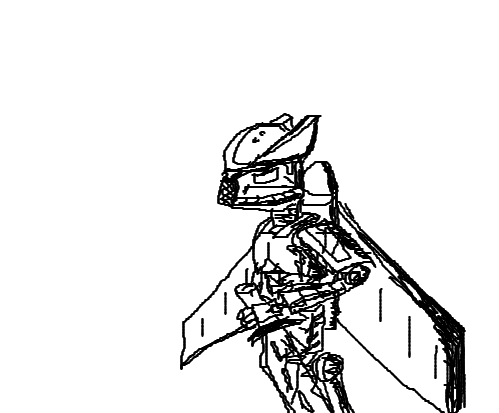Chapter 2
A female Onu-Matoran named Andaleus opened the flap on the newspaper stand and pulled out the latest copy of The Synthesis, the paper that she wrote for. Just as planned, her article was placed in a nice column slot on the front page. She frowned as she saw that the stack for The Onu-Metro Report, their biggest competitor, had sold at least four times more copies than they had.
“Of course they did,” she muttered as she saw their highly sensationalist tabloid-esque headlines. She kept on her way as she thumbed through the paper. One article, a retrospective of the civil conflict thus far, particularly peaked her interest.
It all started when Ta-Metru barges were bombed by Po-Matoran members of a sculptors’ guild turned militant rebel faction called the Friends of Po-Metru (FPM). While it was shocking, it wasn’t unexpected; tensions between Ta-Metru and Po-Metru had been bristling for years now. Most of the drama was tied around competing markets. Both of the districts had historically been heavily invested in the manufacturing sector, and in recent years competition skyrocketed because disruptions in foreign trade routes (such as Stelt and Xia) brought a poverty wave throughout the city.
‘The problem, however, was not simply restricted to market competition,’ contemplated Andaleus to herself. ‘The problem is their bosses.’
All of the Matoran bosses, who were already wicked people in their own right thanks to their rampant labor exploitation, managed to cultivate a unique-cross Metru hatred among their labor force. Whenever sales fell, the Po-Matoran boss would blame it on the Ta-Metru goods, and vice-versa, whether or not that was actually the case. The governments of the Metrus soon caught onto this as well. Politicians managed to appease their people by “protecting the Metru’s markets from Ta/Po-Matoran influences,” and so on. Labor unions, which were once instruments of cross-elemental solidarity among the working class soon became the mouthpiece of this sentiment. Ta and Po workers’ unions soon became more focused on beating out their rivals in the opposite Metru than they were on advocating for the rights of workers within their district.
The entire process was bizarre. Andaleus had the privilege of covering most of the conflict leading up to the May Days.

As their name suggested, the May Days began on May 5th, about a month prior to the present day. It was on that day that the FPM bombed the Ta-Metru barges. It was an attack motivated by nothing but false conspiracy: a lie perpetuated by the bosses to make their workers slave over their work for longer and harder hours, motivated by zealous desire to outdo their opponent district.
The government of the Ta-Metru district immediately reacted with sanctions against Po-Metru (although there were already plenty of sanctions in place already, but it was a nice PR move). The government of Po-Metru played the victim card, saying that it was unfair that all of Ta-Metru sanctioned Po-Metru’s private and public sectors, despite the attack being carried out by a small handful of radicals. As it turned out, the “small handful of radicals” wasn’t actually that small, since countless demonstrations erupted all across the Metru in support of the FPM and in condemnation of Ta-Metru’s sanctions. Counter-demonstrations emerged on the Ta-Metru side as well.
Commissioner Kath, the Turaga-appointed governor of Ta-Metru, authorized the creation of a “Civil Guard,” which was a conglomerate of several reactionary labor unions that were given free armaments by the district government to “protect Ta-Matoran interests.”
The ports of Ta-Metru became a bit of a war zone in the following week. Po-Matoran, in collaboration with some seedy Ga-Matoran smugglers, were able to sneak bombs and other explosives onto Ta-Matoran barges and transport vessels, resulting in the deaths of upwards of a hundred deckhands and dock workers. Meanwhile, the Civil Guard went on a bit of a witch hunt within Ta-Metru’s borders, arresting almost every Po-Matoran they could find, whether they be there on business trips, visiting friends, or any other reason. Over 20 Po-Matoran were detained and beaten by the Civil Guards as a result of the growing paranoia. Le-Metru was one of the first districts to call this out, with Commissioner Mreza denouncing Kath’s programs. Le-Metru was hit with sanctions shortly afterwards.
After a few days of grotesque political juggling between the two districts, Commissioner Jixlin of Po-Metru eventually received an unfriendly notification from the desk of Commissioner Kath that if he did not outlaw the FPM within the next day, he would declare open war on the organization.
This was when things got even more complicated than they already were. Jixlin issued a decree to outlaw the FPM, despite the fact that he didn’t actually order any of the District Police to do anything about them. Regardless, this proved to be an opportune excuse for the FPM to declare war on the government of Po-Metru. They took up arms and stormed into the southern peninsula of the district, seized control of the chutes that linked Po-Metru to the Coliseum, and declared themselves to be an independent district, known as “Real Po-Metru.” They also claimed to have control of the rest of the district as well. This finally prompted Jixlin to mobilize the District Police against them. It was during these events that the distinction between the FPM-occupied territory and the government-occupied territory arose; the FPM declared themselves as the “Real Po-Metru,” while the district government was known by the public as the “Official Po-Metru.” This distinction was, at least, more common in Po, Le, and Ko-Metru, where sentiment for the FPM and the Real Po-Metru were higher than in Onu, Ga, and Ta-Metru, where the standard title of “FPM” and “Po-Metru government” were used more frequently. A Po-Matoran named Lohksun, who was previously operating as a field commander for the FPM, declared herself as the real Commissioner of Po-Metru, after being approved by a popular vote of FPM members.
With Real Po-Metru occupying the southern peninsula and Commissioner Lohksun decrying the legitimacy of Commissioner Jixlin, Official Po-Metru was effectively cut off from trading goods with the Coliseum, which severely endangered their commodity trade with the rest of Metru Nui and the universe. Furthermore, several zealous pro-Ta-Metru Onu-Matoran took it upon themselves to tamper with the chutes connecting Official Po-Metru to Onu-Metru to show their solidarity with Real Po-Metru, however they were quickly shut down by Commissioner Heidakama of Onu-Metru. In the growing chaos, Commissioner Kath took it upon himself to finally mobilize the Civil Guard against Real Po-Metru. Hundreds of conscripts put down their factory tools and picked up weapons as they poured through the Ta-Metru chutes into the Coliseum stormed across the land bridge to the southern Po-Metru peninsula, where they engaged the FPM in street combat. At first the FPM had the advantage since they knew the land better and had already set up barricades in the streets to protect against such an event. However the Ta-Matoran had better weapons and greater numbers, and were able to push them back within about three days. On the third day the first death of the battle was declared: a young Po-Matoran named Tuku died while he was attempting to sneak across a street intersection and was shot by a Civil Guard who was perched in a window of a factory. Tuku’s death was widely reported across Po-Metru by the FPM, and many Po-Matoran rushed out of Official Po-Metru and into Real Po-Metru to avenge the death of their kinsman. This influx in numbers was able to stop the Civil Guards from continuing their advance, however they were only able to reclaim a minimal amount of territory afterwards. They also lost a key building to the District Police of Official Po-Metru when they launched a pyrrhic attack from the north, however the factory they were fighting over was so badly damaged in the conflict that it was of no practical use to the District Police after they seized control of it.
On the fourth day of the street battle in Real Po-Metru, Commissioner Kath of Ta-Metru effectively betrayed what little trust he had built up with Commissioner Jixlin, named both Real Po-Metru and Official Po-Metru as “rump states,” declared the Civil Guard-occupied Po-Metru territory as the “Lawful Po-Metru,” and nominated one of his generals, a Ta-Matoran named Aft, as its Commissioner.
So by the time Andaleus was skimming through her paper, the headache-inducing situation looked like this:
Three political entities were claiming to be the legitimate governing bodies over the district of Po-Metru: the native governmental authority of Official Po-Metru, the FPM-occupied Real Po-Metru, and the Civil Guard-occupied Lawful Po-Metru.
Three Matoran were claiming to be the Commissioners of all of Po-Metru: Jixlin of Official Po-Metru, Lohksun of Real Po-Metru, and Aft of Lawful Po-Metru, who was essentially a puppet of Kath of Ta-Metru.
Only one outside Metru had taken any action in regards to these events, which was when Commissioner Mreza of Le-Metru denounced the Civil Guard’s treatment of Po-Matoran who were within Ta-Metru borders.
Andaleus sighed and tucked the paper away into her backpack. The entire situation was horrendous.

